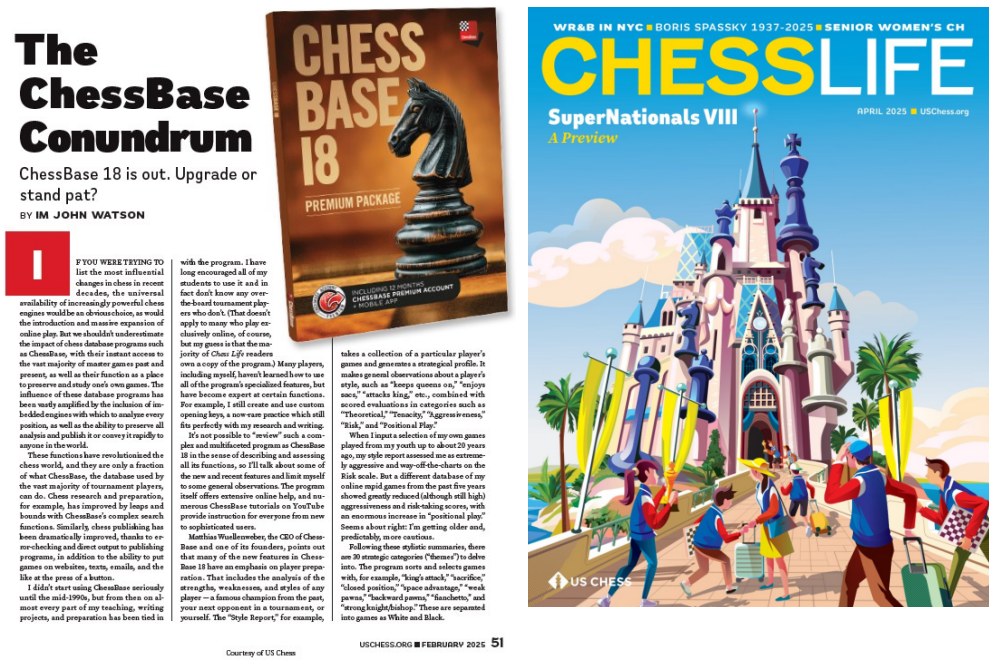| The following review first appeared in Chess Life 4/2025. Reprinted with kind permission. |
 |
By John Watson
The ChessBase Conundrum
ChessBase 18 is out. Upgrade or stand pat?
If you were trying to list the most influential changes in chess in recent decades, the universal availability of increasingly powerful chess engines would be an obvious choice, as would
the introduction and massive expansion of online play. But we shouldn't underestimate the impact of chess database programs such as ChessBase, with their instant access to the vast majority of master games past and present, as well as their function as a place to preserve and study one's own games. The influence of these database programs has been vastly amplified by the inclusion of imbedded engines with which to analyze every position, as well as the ability to preserve all analysis and publish it or convey it rapidly to anyone in the world.
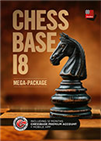 Winning starts with what you know
Winning starts with what you know
The new version 18 offers completely new possibilities for chess training and analysis: playing style analysis, search for strategic themes, access to 6 billion Lichess games, player preparation by matching Lichess games, download Chess.com games with built-in API, built-in cloud engine and much more.These functions have revolutionized the chess world, and they are only a fraction of what ChessBase, the database used by the vast majority of tournament players, can do. Chess research and preparation, for example, has improved by leaps and bounds with ChessBase's complex search functions. Similarly, chess publishing has been dramatically improved, thanks to error-checking and direct output to publishing programs, in addition to the ability to put games on websites, texts, emails, and the like at the press of a button.
I didn't start using ChessBase seriously until the mid-1990s, but from then on almost every part of my teaching, writing projects, and preparation has been tied in with the program. I have long encouraged all of my students to use it and in fact don't know any over-the-board tournament players who don't. (That doesn't apply to many who play exclusively online, of course, but my guess is that the majority of Chess Life readers own a copy of the program.) Many players, including myself, haven't learned how to use all of the program's specialized features, but have become expert at certain functions. For example, I still create and use custom opening keys, a now-rare practice which still fits perfectly with my research and writing.
It's not possible to "review" such a complex and multifaceted program as ChessBase 18 in the sense of describing and assessing all its functions, so I'll talk about some of the new and recent features and limit myself to some general observations. The program itself offers extensive online help, and numerous ChessBase tutorials on YouTube provide instruction for everyone from new to sophisticated users.
Matthias Wuellenweber, the CEO of ChessBase and one of its founders, points out that many of the new features in ChessBase 18 have an emphasis on player preparation. That includes the analysis of the strengths, weaknesses, and styles of any player - a famous champion from the past, your next opponent in a tournament, or yourself. The "Style Report," for example, takes a collection of a particular player's games and generates a strategical profile. It makes general observations about a player's style, such as "keeps queens on," "enjoyssacs," "attacks king," etc., combined with scored evaluations in categories such as "Theoretical," "Tenacity," "Aggressiveness," "Risk," and "Positional Play."
When I input a selection of my own games played from my youth up to about 20 years ago, my style report assessed me as extremely aggressive and way-off-the-charts on the Risk scale. But a different database of my online rapid games from the past five years showed greatly reduced (although still high) aggressiveness and risk-taking scores, with an enormous increase in "positional play." Seems about right: I'm getting older and, predictably, more cautious.
Following these stylistic summaries, there are 30 strategic categories ("themes") to delve into. The program sorts and selects games with, for example, "king's attack," "sacrifice," "closed position," "space advantage," "weak pawns," "backward pawns," "fianchetto," and "strong knight/bishop." These are separated into games as White and Black.
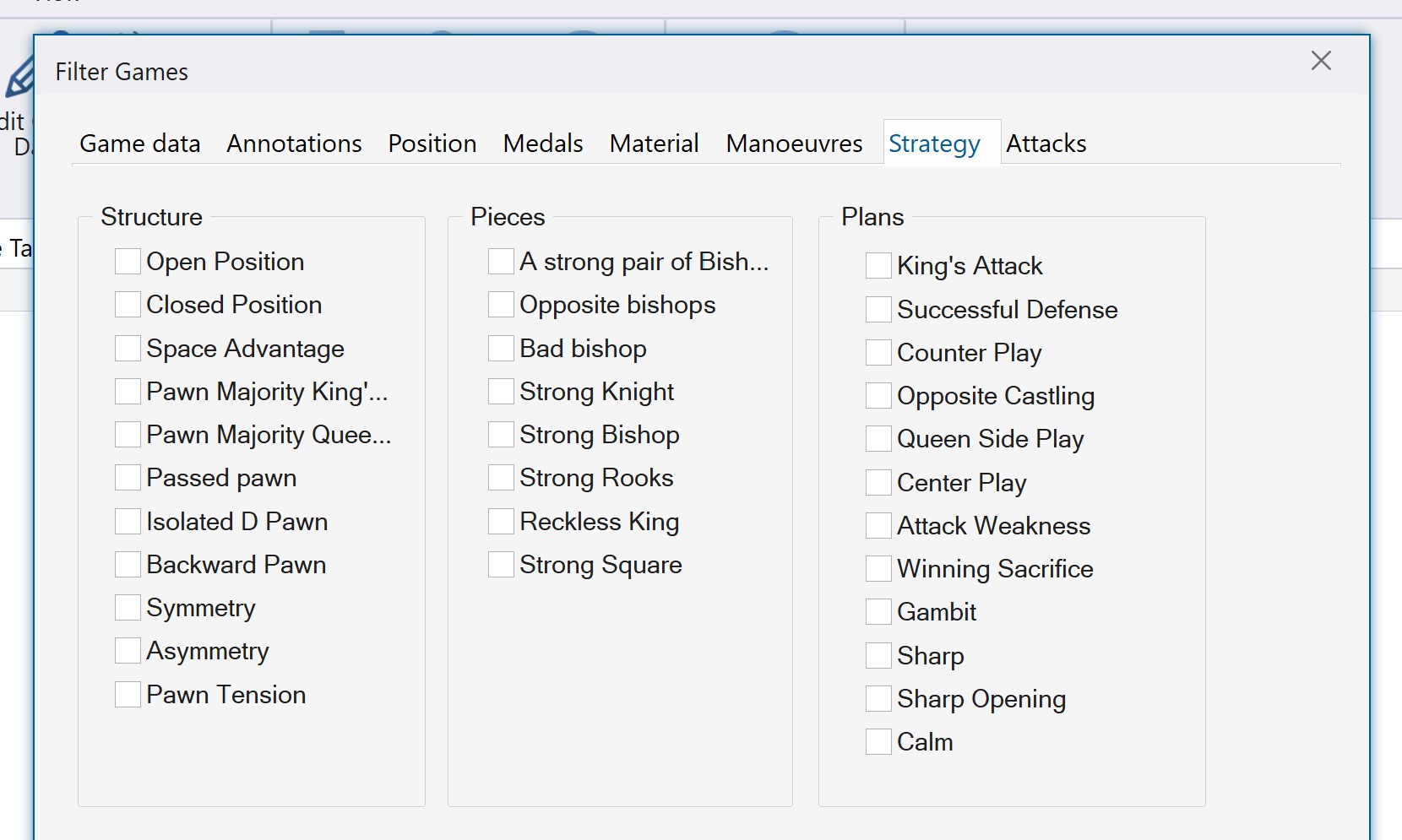
With CB18 you can easily search games for specific positional structures and themes.
For each of the lists, you can play through individual games. In this way, you might spot your next opponent's weaknesses and can familiarize yourself with how they play diverse types of positions. Perhaps more importantly, if you're willing to put some time in, you can use this function to see which parts of your own game need work, and adjust your study routines accordingly.
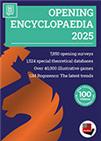 YOUR EASY ACCESS TO OPENING THEORY: Whether you want to build up a reliable and powerful opening repertoire or find new opening ideas for your existing repertoire, the Opening Encyclopaedia covers the entire opening theory on one product.
YOUR EASY ACCESS TO OPENING THEORY: Whether you want to build up a reliable and powerful opening repertoire or find new opening ideas for your existing repertoire, the Opening Encyclopaedia covers the entire opening theory on one product.The "Error Report" is generated much more slowly than the Style Report and has a simpler output; still, this is also a potentially very useful feature. For any set of games by a player, you get a "Blunder ELO," which is handy to compare against the player's ELO, and a magnitude distribution, which shows how bad the blunders are. This and other results are compared with those of a group of average GMs, which uses a large-enough sample of GMs to be quite trustworthy. It generates charts which assess factors such as "Magnitude [of errors] vs. Complexity," "Impact [of errors] on Result," and "Blunder Context" (what part of the game the error occurred, whether the player was under attack, etc.).
I tried this on my own games and some student games, and it's revealing to see when and in what context one's errors occur. It turns out that I make fewer errors than the average GM in positions where I stand better, but err much more often when I stand worse, and in particular when my errors can still affect the result. Also, my "tenacity" scores, which used to be high, have fallen dramatically with age.
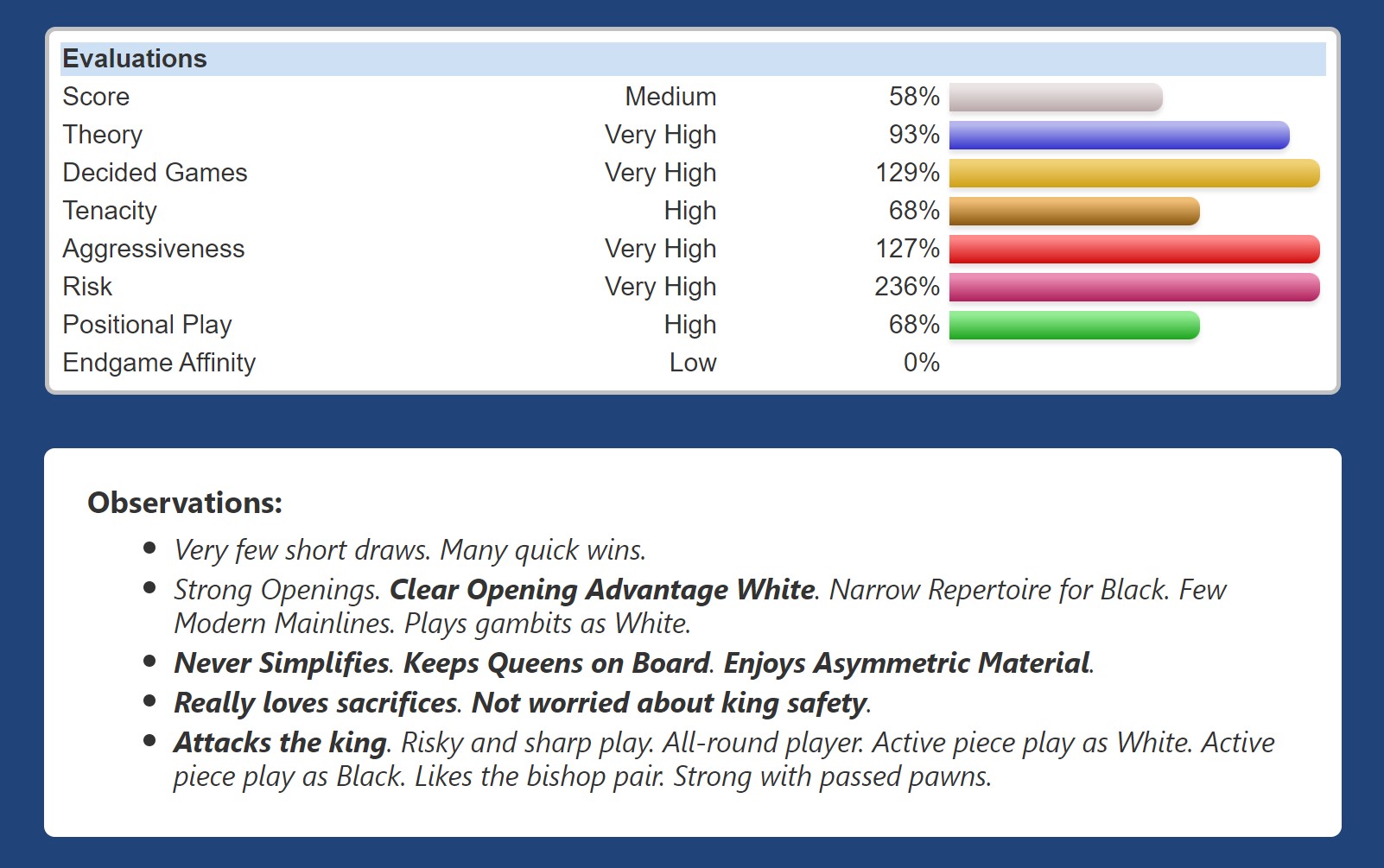
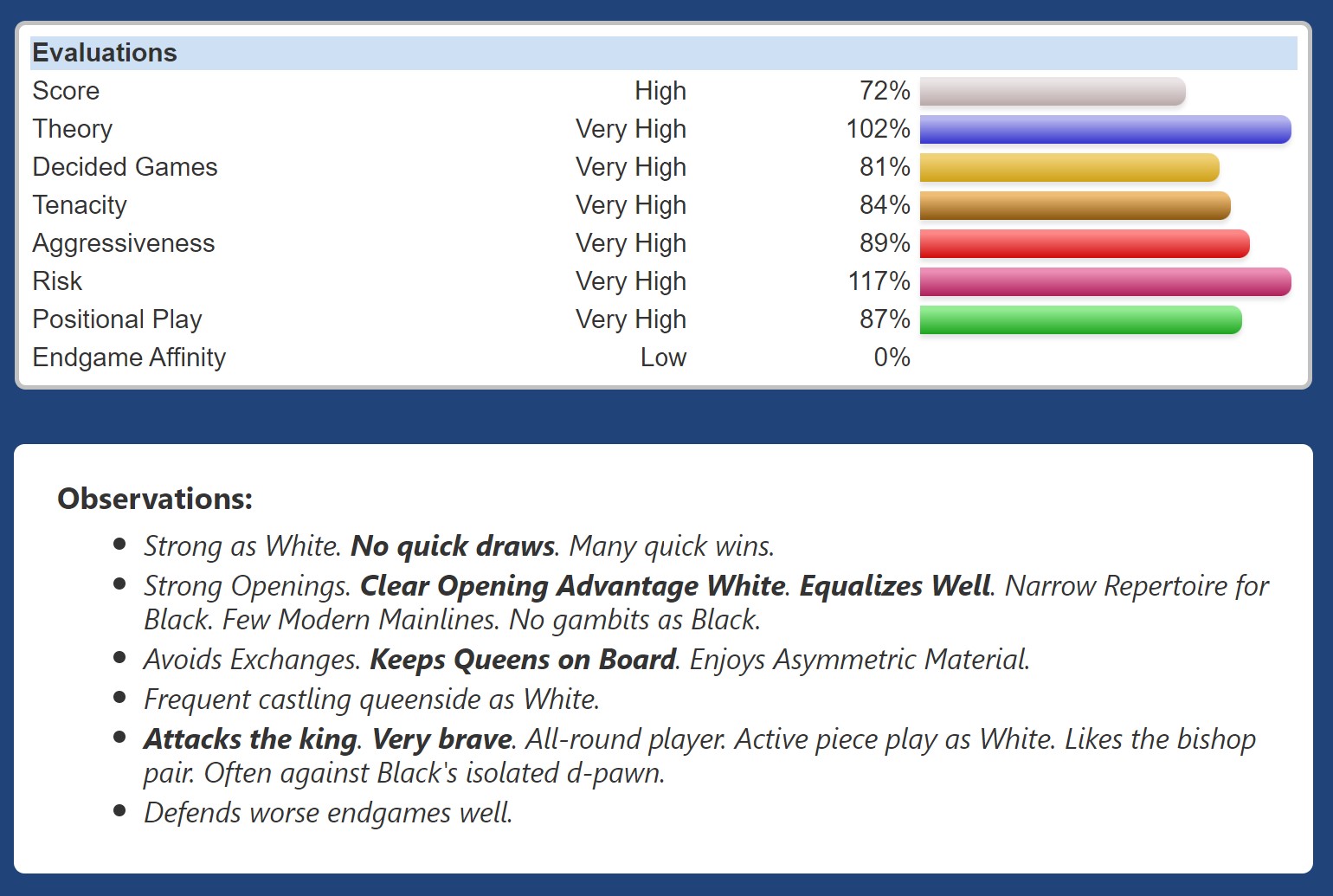
Watson's style ratings for games up to 1999 (top) and for online games after 2020 (bottom)
Another nice feature (initially introduced in ChessBase 17, but of which I was unaware) involves finding beauty in games. You can take any database games list and select "Set Beauty," and ChessBase generates a new column assigning 0, 1, 2, or 3 beauty icons for each game; essentially, the game is analyzed as having various degrees of sacrificial tactical content. I had fun with recent tournament databases locating exciting games in this way. It doesn't take too long to run the process on a small database of personal games, for example, although it can take hours when applied to a database with millions of games.
One caution here: The beauty search only works on databases that were created with the newer .2cbh format (introduced with CB17). So if you have an old .cbh database of your games, for example, you can create a new empty database with the .2cbh format, copy your games into it, and then use the "Set Beauty" function. Sometimes you'll be surprised to find that your games are more interesting, and your ideas more attractive, than you'd realized!
A considerable number of other new features come with ChessBase 18, some functional and others matters of convenience or efficiency. Many players will be interested in using the powerful remote engines ChessBase offers. In contrast to the cloud engines available in previous editions, here ChessBase offers remote access to engines of varying speeds directly within the engine dialog.
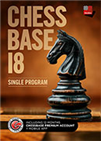 Winning starts with what you know – ChessBase 18
Winning starts with what you know – ChessBase 18The first tier of remote engines is free to use if you have a premium account; for faster speeds, you can buy "ducats" (10 ducats cost one euro) and rent access by the minute or hour. Interested parties can also download a remote access plugin for previous editions of ChessBase (or, in theory, any program using UCI engines) at remoteengine.chessbase.com.
Preparing for opponents in the online age has been simplified in CB18. Instead of scouring websites and downloading individual .pgns, you are now able to access and download games from Lichess and Chess.com directly via ChessBase. If you don't know a player’s online username, you can have the program perform some sleuthing to try to discover it; at worst, you'll end up with games played online by someone with a similar style, which could be useful.
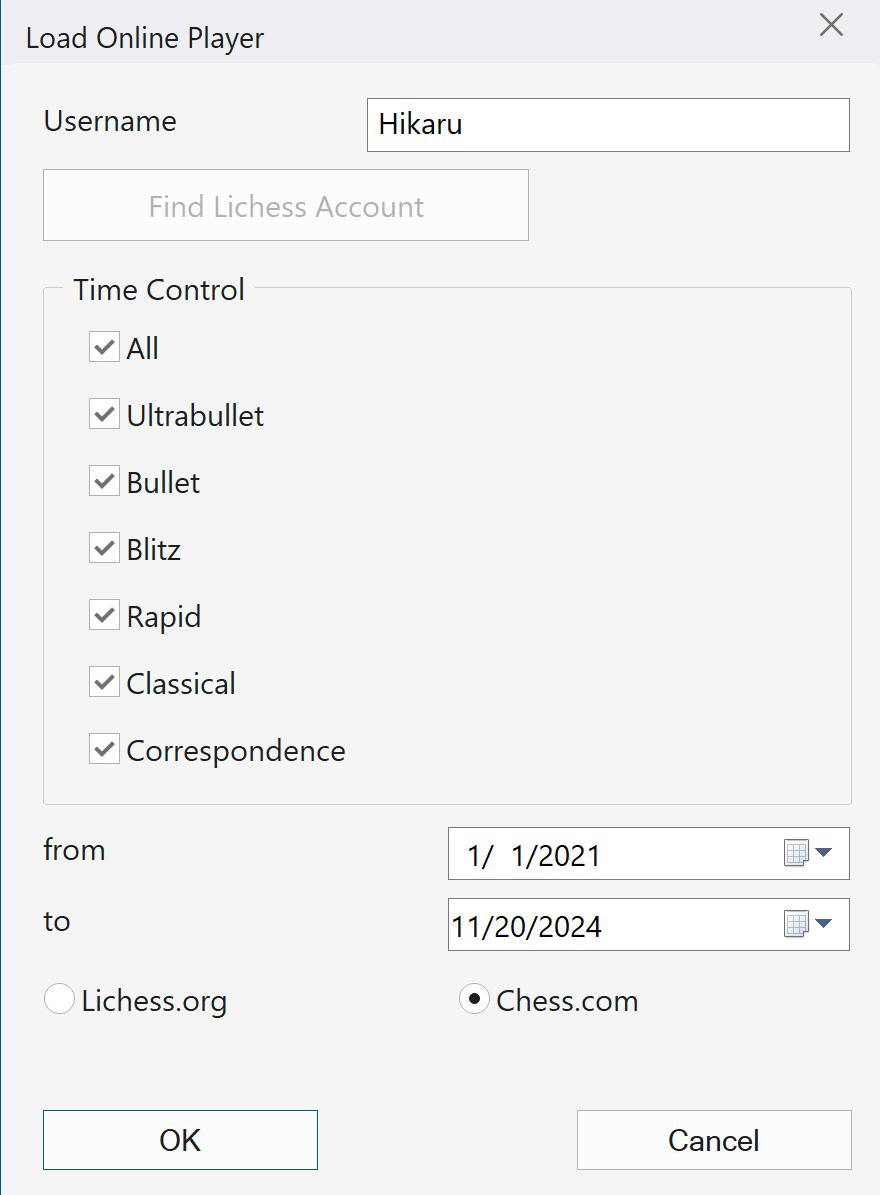
The native search field for online games
Another topical feature is the new ChessBase mobile app, which you can access from any browser at app.chessbase.com. This will soon be released as a freestanding app for mobile phones. If you want to send an annotated game to someone, you can create a QR code for any game in CB18 and send it to someone who can then open it in the mobile app, which is more convenient than creating and archiving databases and then sending them by email. These are a few new features which illustrate how ChessBase programmers strive to keep up with the evolving technology.
The companion product MegaBase 2025 is a high-quality database published by ChessBase with more than 11 million games. There are plenty of other databases and sources of games to use with the ChessBase program, but if the extra money isn't a major concern, it has some features worth noting. For one thing, MegaBase 2025 has more than 120,000 games with master annotations not found in other databases. Also, the price includes an update service that supplies about 5,000 games a week for one year; you could try to replace these with games from other sources on the web, but that's at best time-consuming. Finally, a "player lexicon" is included, with 1.4 million player names and more than 44,000 player photos (these are only compatible with CB16, CB17, and CB18). For players with limited budgets, MegaBase 2025 is a bit of a luxury, but I suspect most ChessBase users will want to have it.
ChessBase 18 comes in different packages at different prices, ranging from the program alone (with access to the online database) to the premium package, which has extras such as Mega Database 2025, ChessBase Magazine, the ChessBase Correspondence Database, and ducats to spend on various ChessBase features, including renting the most powerful engines for analysis.
I should note that for owners of CB17, the upgrade to CB18 is 150 euros on the ChessBase site, indicating that once you're a user, the expense of upgrading every few years is not as intimidating as the initial investment. I would argue that ChessBase is practically a necessity for advanced players and regular tournament participants. While you needn't update with every iteration, there are enough attractive features in each new version that you shouldn't skip more than one or two upgrades. In the case of ChessBase 18, I find the player preparation features particularly attractive, both for preparing for opponents and examining one's own play, and the ability to search for online games within the program feels like a game-changer.
To be sure, many casual online players will understandably not feel the need for such a powerful tool, but anyone serious about significantly improving their chess will almost certainly benefit from this program. It will not only accelerate your development but also allow you to keep up with your competition, who are more than likely using ChessBase to prepare for your next encounter.
Winning starts with what you know
The new version 18 offers completely new possibilities for chess training and analysis: playing style analysis, search for strategic themes, access to 6 billion Lichess games, player preparation by matching Lichess games, download Chess.com games with built-in API, built-in cloud engine and much more.
 |
Chess Life
The monthly magazine Chess Life, founded in 1946, is the official magazine of the United States Chess Federation (US Chess). Chess Life reaches a quarter of a million readers every month and is considered the most widely read chess magazine in the world.
The focus of the articles is on players and tournaments in the USA.
All members of the US Chess Federation and affiliated clubs automatically receive access to the online version of the monthly Chess Live issues.
Affiliated clubs and certain categories of members also receive the printed copies of Chess Life. |
